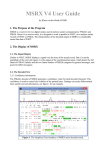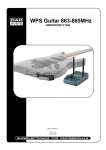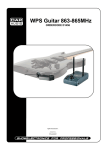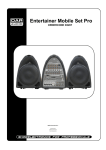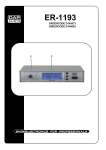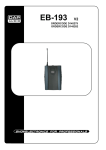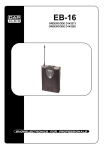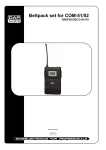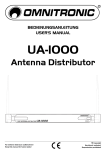Download DAPAudio pss-110 Product guide
Transcript
PSS-10 ORDERCODE D2604 Congratulations! You have bought a great, innovative product from DAP Audio. The DAP Audio brings excitement to any venue. Whether you want simple plug-&-play action or a sophisticated show, this product provides the effect you need. You can rely on DAP Audio, for more excellent audio products. We design and manufacture professional audio equipment for the entertainment industry. New products are being launched regularly. We work hard to keep you, our customer, satisfied. For more information: [email protected] You can get some of the best quality, best priced products on the market from DAP Audio. So next time, turn to DAP Audio for more great audio equipment. Always get the best -- with DAP Audio ! Thank you! Dap Audio Dap Audio PSS-10™ Product Guide Warning.........................................................................................................................................................................2 Unpacking Instructions...........................................................................................................................................2 Safety-instructions...................................................................................................................................................2 Operating Determinations.....................................................................................................................................3 Return Procedure....................................................................................................................................................4 Claims.......................................................................................................................................................................4 Description....................................................................................................................................................................5 Overview.................................................................................................................................................................5 CD-player................................................................................................................................................................6 Mixer.........................................................................................................................................................................9 Wireless Microphone..............................................................................................................................................10 Remote Control......................................................................................................................................................11 Installation....................................................................................................................................................................12 Set Up and Operation.................................................................................................................................................12 Operating on AC power.......................................................................................................................................12 Operating on battery power................................................................................................................................13 Charging the PSS-10 built in batteries..................................................................................................................13 Changing the batteries of the PSS-10..................................................................................................................13 CD-Operations.............................................................................................................................................................13 Loading a CD.........................................................................................................................................................13 Unloading CD’s.......................................................................................................................................................13 CD’s/ MP3-discs/ USB sticks/ SD- MMC cards......................................................................................................13 Selecting Tracks......................................................................................................................................................13 Starting Playback ..................................................................................................................................................13 Stop Playback.........................................................................................................................................................14 Pausing....................................................................................................................................................................14 Operating of the wireless microphones...................................................................................................................14 Inserting/changing the battery............................................................................................................................14 Tips for achieving maximum performance.........................................................................................................14 Before switching off the power..................................................................................................................................14 Approval........................................................................................................................................................................ 15 Declaration of conformity...........................................................................................................................................16 Connection Cables………..………………………………………………………………………..….…..……...................19 Maintenance...............................................................................................................................................................20 Replacing a fuse.........................................................................................................................................................20 Troubleshooting...........................................................................................................................................................20 Product Specifications................................................................................................................................................21 1 WARNING FOR YOUR OWN SAFETY, PLEASE READ THIS USER MANUAL CAREFULLY BEFORE YOUR INITIAL START-UP! Unpacking Instructions Immediately upon receiving this product, carefully unpack the carton and check the contents to ensure that all parts are present, and have been received in good condition. Notify the dealer immediately and retain packing material for inspection if any parts appear damaged from shipping or the carton itself shows signs of mishandling. Save the carton and all packing materials. In the event that a fixture must be returned to the factory, it is important that the fixture be returned in the original factory box and packing. Your shipment includes: • DAP PSS-10 • 2x Wireless Microphone • 2x Antenna • Remote control • IEC cable (175cm) • User manual WARNING CAUTION! Keep this system away from rain and moisture! SAFETY INSTRUCTIONS Every person involved with the installation, operation and maintenance of this system has to: be qualified follow the instructions of this manual CAUTION! Be careful with your operations. With a dangerous voltage you can suffer a dangerous electric shock when touching the wires! Before you initial start-up, please make sure that there is no damage caused by transportation. Should there be any, consult your dealer and do not use the system. To maintain perfect condition and to ensure a safe operation, it is absolutely necessary for the user to follow the safety instructions and warning notes written in this manual. Please consider that damages caused by manual modifications to the system are not subject to warranty. This system contains no user-serviceable parts. Refer servicing to qualified technicians only. 2 IMPORTANT: The manufacturer will not accept liability for any resulting damages caused by the nonobservance of this manual or any unauthorized modification to the system. Never let the power-cord come into contact with other cables! Handle the power-cord and all connections with the mains with particular caution! Never remove warning or informative labels from the unit. Never use anything to cover the ground contact. Never leave any cables lying around. Do not insert objects into air vents or bassreflex ports. Do not connect this system to a dimmerpack. Do not switch the system on and off in short intervals, as this would reduce the system’s life. Do not open the device and do not modify the device. Do not drive the inputs with a signal level bigger, than required to drive the equipment to full output. Only use system indoor, avoid contact with water or other liquids. Avoid flames and do not put close to flammable liquids or gases. Always disconnect power from the mains, when system is not used. Only handle the power-cord by the plug. Never pull out the plug by tugging the power-cord. Always operate the unit with the AC ground wire connected to the electrical system ground. Make sure you don’t use the wrong kind of cables or defective cables. Make sure that the available voltage is not higher than stated on the rear panel. Make sure that the power-cord is never crimped or damaged. Check the system and the powercord from time to time. Please turn off the power switch, when changing the power cord or signal cable, or select the input mode switch. Extreme frequency boosts in connection with a high input signal level may lead to overdriving your equipment. Should this occur, it is necessary to reduce the input signal level by using the input control. Avoid ground loops! Always be sure to connect the power amps and the mixing console to the same electrical circuit to ensure the same phase! If system is dropped or struck, disconnect mains power supply immediately. Have a qualified engineer inspect for safety before operating. If the system has been exposed to drastic temperature fluctuation (e.g. after transportation), do not switch it on immediately. The arising condensation water might damage your system. Leave the system switched off until it has reached room temperature. If your Dap Audio device fails to work properly, discontinue use immediately. Pack the unit securely (preferably in the original packing material), and return it to your Dap Audio dealer for service. Repairs, servicing and electric connection must be carried out by a qualified technician. For replacement use fuses of same type and rating only. WARRANTY: Till one year after date of purchase. OPERATING DETERMINATIONS This system is not designed for permanent operation. Consistent operation breaks will ensure that the system will serve you for a long time without defects. If this system is operated in any other way, than the one described in this manual, the product may suffer damages and the warranty becomes void. Any other operation may lead to dangers like short-circuit, burns, electric shock, etc. You endanger your own safety and the safety of others! Improper installation can cause serious damage to people and property ! 3 Connection with the mains Connect the device to the mains with the power-plug. Always pay attention, that the right color cable is connected to the right place. International EU Cable UK Cable US Cable Pin L BROWN RED YELLOW/COPPER FASE N BLUE BLACK SILVER NUL YELLOW/GREEN GREEN GREEN EARTH Make sure that the device is always connected properly to the earth! Return Procedure Returned merchandise must be sent prepaid and in the original packing, call tags will not be issued. Package must be clearly labeled with a Return Authorization Number (RMA number). Products returned without an RMA number will be refused. Highlite will not accept the returned goods or any responsibility. Call Highlite 0031-455667723 or mail [email protected] and request an RMA prior to shipping the fixture. Be prepared to provide the model number, serial number and a brief description of the cause for the return. Be sure to properly pack fixture, any shipping damage resulting from inadequate packaging is the customer’s responsibility. Highlite reserves the right to use its own discretion to repair or replace product(s). As a suggestion, proper UPS packing or double-boxing is always a safe method to use. Note: If you are given an RMA number, please include the following information on a piece of paper inside the box: 1) Your name 2) Your address 3) Your phone number 4) A brief description of the symptoms Claims The client has the obligation to check the delivered goods immediately upon delivery for any shortcomings and/or visible defects, or perform this check after our announcement that the goods are at their disposal. Damage incurred in shipping is the responsibility of the shipper; therefore the damage must be reported to the carrier upon receipt of merchandise. It is the customer's responsibility to notify and submit claims with the shipper in the event that a fixture is damaged due to shipping. Transportation damage has to be reported to us within one day after receipt of the delivery. Any return shipment has to be made post-paid at all times. Return shipments must be accompanied with a letter defining the reason for return shipment. Non-prepaid return shipments will be refused, unless otherwise agreed in writing. Complaints against us must be made known in writing or by fax within 10 working days after receipt of the invoice. After this period complaints will not be handled anymore. Complaints will only then be considered if the client has so far complied with all parts of the agreement, regardless of the agreement of which the obligation is resulting. 4 Description of the device Features • Portable sound system with CD player and two wireless microphones • Built in self- charging battery pack • Output power maximum 25 Wrms • Built in Tuner/CD/USB/SD- player • 2 Wireless microphones included Overview Fig. 1 1. Tuner/CD-player 2. Microphone A/B receivers 3. Powered Mixer 5 CD-player Fig. 2 1) Mute Button Use this button to mute the output. 2) Mode Button This button lets you select Radio, aux, CD, USB, SD as a source for payback. You can’t select the CD, USB or SD slot if there is no media (CD, USB stick or SD card) inserted. 3) P-EQ Button Pressing the PEQ button gives you direct access to the P-EQ function. Pressing the button lets you select between four EQ presets or bypass the DSP circuit. ROCK: POP: CLAS: FLAT: Gives you a frequency response optimized for rock music. Gives you a frequency response optimized for pop music. Gives you a frequency response optimized for classical music. Gives you a flat frequency response. 4) APS Button Pressing and holding this button starts APS. If APS is activated, the radio will scan the FM band for stations and automatically store them in memory. If you decide to exit APS before the search is finished, press the APS button again. 5) F.Skip Button In CD/MP-3 mode: Press this button to skip to the next track. In Radio mode: While searching for a station manually. The frequency will increase each time you press the button. Pressing and holding the button for more than 1 second starts a forward auto search. In auto search, the tuner will search the frequency band until a station of sufficient strength is found. 6) LCD Display 7) Release Button Releases the front panel to get access to the CD-slot. 8) USB Slot Use this slot to connect your USB stick for MP-3 playback. 9) B.Skip Button In CD/MP-3 mode: Press this button to skip to the previous track. In Radio mode: While searching for a station manually. The frequency will decrease each time you press the button. Pressing and holding the button for more than 1 second starts a downward auto search. In auto search, the tuner will search the frequency band until a station of sufficient strength is found. 6 10) Band Button Use this button to select the desired band. Pressing the button several times let’s you select one of five bands as shown below. 11) Power Button Use the power button to turn the device on or off. 12) Volume/Select Control Press the control to select between the volume, bass, treble, fader or balance functions as shown below. VOL: BAS: TRE: BAL: FAD: Turn the control to increase or decrease the volume. Turn the control to increase or decrease the bass frequencies. Turn the control to increase or decrease the treble frequencies. This function has no effect in the PSS-08. This function has no effect in the PSS-08. Pressing and holding the control for 2 seconds enables you to toggle the loudness function on or off. The loudness function gives you a fatter sound on low signal levels. 13) Clock button Pressing the clock button once, shows the clock. Press again and the hours display will blink, using the Volume/Select Control (12) allows you to adjust the hours. Pressing the clock button repeately let’s you do the same for the minutes and seconds and finaly let’s you return to the normal display as shown in the figure below. As soon as you switch the Power switch (42) in off (0) position, the clock will lose it’s settings. 14) 1/PAU buton In Radio mode you can use this button to browse through the memory presets. In CD/MP-3 mode you can use this button to start/pause playback. 15) 2/INT Button In CD/MP-3 mode, pressing this button will start the intro mode. In intro mode, the device only plays the first seconds of the content of the CD, USB-stick or SD-card. In Radio mode, pressing this button will select preset 2. 16) 3/RPT Button In CD MP-3 mode, pressing this button allows you to repeat the current track. Exit the repeat mode by pressing the button again. When in Radio mode, pressing this button will select preset 3. 17) 4/RDM button In Radio mode you can use this button to browse through the memory presets. In CD/MP-3 mode you can use this button to toggle random play on or off. 18) 5/-10 button This button allows you to decrease parameter values (e.g. Volume, bass etc). It has the same effect as turning the Select Control to the left. 19) 6/+10 button This button allows you to decrease parameter values (e.g. Volume, bass etc). It has the same effect as turning the Select Control to the left. 20) IR receive window This sensor receives the information of the remote control. Don’t place any object or sticker in front of the sensor. 21) SD/MMC-card Slot Use this slot to connect your SD/MMC-card for MP-3 playback. 7 Fig. 3 22) CD-slot 23) Eject Button Press this button to eject the CD. 24) Reset Button Press this button in case you need to reset the unit. Wireless Mic Receiver Fig. 4 25) Channel A Antenna connector 26) Channel A Audio level indicator Indicates the level of the incoming audio signal. 27) Channel A RF indicator Lights if the carrierwave of the wireless microhone is received. 28) Channel A Volume control. Used to adjust the output level of channel A. 29) Channel B Volume control. Used to adjust the output level of channel B. 30) Channel B RF indicator Lights if the carrierwave of the wireless microhone is received. 31) Channel B Audio level indicator Indicates the level of the incoming audio signal. 32) Channel B Antenna connector 8 Mixer Fig. 5 33) Mic 1 level Use this control to adjust the volume of the Mic 1 input (49). 34) Mic 2 level Use this control to adjust the volume of the Mic 2 input (50). 35) Mic 3 level Use this control to adjust the volume of the Mic 3 input (51). 36) High Use this control to adjust the High frequencies. 37) Low Use this control to adjust the Bass frequencies. 38) Echo level Use this control to adjust the level of the built in echo effect. 39) CD/ Tun. level Use this control to adjust the level of the built in Car Radio. 40) AUX level Use this control to adjust the level of the Aux (41) input. 41) AUX input Stereo Unbalanced RCA Stereo Line level input. 42) Power ON/ OFF/ CHARGE switch Position I is on, position II is charge, in between position is off. 43) Power LED Lights green if the device is powered on. Lights orange if the batteries run low (in case of battery Power). 44) Charge LED Blinks if the built in battery is being charged. Light continuously if the battery is 100% charged. 45) AC Inlet with integrated fuse holder. This connector is meant for the connection of the supplied main cord. Connect one end of the power cord to the connector, the other end to the mains, then switch the Power (42) in positon I for operating the unit on AC power. Note: Please make sure that the supply voltage matches the operation voltage before connecting the unit to mains. Replace the fuse only with a fuse of same specification (250V:T1,6A). 9 46) 115V/230V Selector Before plugging the PSS-10 into a wall socket, make sure that the 115V/230V Selector is set to the proper voltage. 47) REC output Stereo RCA line level output 48) Line Output ¼” mono unbalanced line level jack output 49) MIC 1 ¼” unbalanced microphone jack input. 50) MIC 2 ¼” unbalanced microphone jack input. 51) MIC 3 Combo balanced/unbalanced microphone input. Wireless Microphone Fig. 6 52) Microphone On LED The red LED will light up shortly if the microphone is turned on. 53) Power On switch Use this switch to turn the microphone On or Off. 54) Battery compartment Access the battery compartment by removing the cover. 10 Remote control Fig. 6 55) PWR Button Use the power button to turn the radio/CD player on or off. 56) 1/►ΙΙ Button In CD/MP-3 mode you can use this button to start/pause playback. In Radio mode, pressing this button will select preset 1. 57) MOD Button This button lets you select Radio, aux, CD, USB, SD as a source for payback. You can’t select the CD, USB or SD slot if there is no media (CD, USB stick or SD card) inserted. 58) 2/INT Button In CD/MP-3 mode, pressing this button will start the intro mode. In intro mode, the device only plays the first seconds of the content of the CD, USB-stick or SD-card. In Radio mode, pressing this button will select preset 2. 59) MUTE Button Use this button to mute the output. 60) 3/RPT Button In CD MP-3 mode, pressing this button allows you to repeat the current track. Exit the repeat mode by pressing the button again. When in Radio mode, pressing this button will select preset 3. 61) 5/-10 Button In CD/MP-3 mode, pressing this button will skip 10 tracks backwards. When in Radio mode, pressing this button will select preset 5. 62) 6/+10 Button In CD/MP-3 mode, pressing this button will skip 10 tracks forwards. When in Radio mode, pressing this button will select preset 6. 64) 4/RDN Button In CD MP-3 mode, pressing this button will start the random mode. In random mode, the device plays the content of the CD, USB-stick or SD-card in random order. When in Radio mode, pressing this button will select preset 4. 65) ►Button In CD/MP-3 mode: Press this button to skip to the next track. Press and hold this button to play the track fast forward. In Radio mode: While searching for a station manually, the frequency will increase each time you press the button. Pressing and holding the button for more than 1 second starts an upwards auto search. In auto search, the tuner will search the frequency band until a station of sufficient strength is found. 66) ENTER/SEL Button Pressing this button allows you to select a parameter. The select button on the remote control has the same function as pressing the select control on the Radio/CD player. 11 67) ◄ Button In CD/MP-3 mode: Press this button to skip to the beginning of the track. Press and hold this button to play the track fast backwards. In Radio mode: While searching for a station manually. The frequency will decrease each time you press the button. Pressing and holding the button for more than 1 second starts a downward auto search. In auto search, the tuner will search the frequency band until a station with sufficient strength is found. 68) VOL+/Menu Button This button allows you to increase parameter values (e.g. Volume, bass etc). It has the same effect as turning the Select Control to the right. 69) VOL-/Menu Button This button allows you to decrease parameter values (e.g. Volume, bass etc). It has the same effect as turning the Select Control to the left. 70) ST/MO Button Press this button to switch between Mono or Stereo mode. Functional only in radio mode. 71) LOUD Button Press this button and use the + and – buttons to switch the loudness function on or off. The loudness increases the bass and treble frequencies and is very useful at low volume levels to give you a fatter sound. 72) LOC/DX Button Press this button and use the + and – buttons to select Local mode. In Local mode, the tuner will only store the strongest (local) stations in memory. Works only in radio mode. 73) SCAN Button While in radio mode, pressing this button will show all preset radio stations. 74) ID3/Band Button Use this button to select the desired band. Pressing the button several times let’s you select one of five bands as shown below. 75) APS/SEARCH Button Pressing and holding this button for more than 3 seconds starts ASM. If ASM activated, the PSS-10 will scan the FM band for stations and automatically store them in memory. If you decide to exit ASM before the search is finished, press the ASM button again. Installation Remove all packing materials from the CD Player. Check that all foam and plastic padding is removed. Connect all cables. Always disconnect from electric mains power supply before cleaning or servicing. Damages caused by non-observance are not subject to warranty. Set Up and Operation Before plugging the unit in, always make sure that the power supply matches the product specification voltage. The power supply is printed on the back of the device. Do not attempt to operate an 115V specification product on 230V power, or vice versa. Connections 1. Turn off the Power switch. 2. Connect the PSS-10 to your other devices you plan on using. CAUTION: Be sure that the power is off, when connecting the cables. Operating on AC power • Make sure the Power (35) switch is in Off (middle) position and connect the power cable. • Switch the Power (35) switch in position I to run the PSS-10. The Power (36) LED will light green. 12 Operating on battery power • Do not connect the power cable. • Switch the Power (35) switch in position I to run the PSS-10. • Switch the Power (35) switch in position 0 if you’re pausing, to save your batteries. • If the batteries are fully charged, the PSS-10 can run on battery power for approximately 5 hours, depending on the volume level. • If the batteries run low, the unit switches off. Charging the PSS-10built in batteries • Make sure the Power (35) switch is in Off (middle) position and connect the power cable. • Switch the Power (35) switch in position II to charge the PSS-10’s internal batteries. • While the PSS-10 is charching, the red Charge (37) LED blinks. • Charge the batteries for at least 8 hours. If the batteries are fully charged, the red Charge (37) LED lights up continuously. Changing the batteries of the PSS-08 • The PSS-10 has three built in batteries which can be accessed through the metal battery cover at the side of the PSS-10. The batteries can be charged aprox. 500 times if used properly. • Normally when fully charged, the PSS-10 can run for about 5 hours depending on the output volume. If the batteries run low very fast, despite being fully charged (at least 8 hours), the batteries ran old and we advise you to change them. • Make sure that you connect the batteries correctly. This means red wire for + and the black wire for – and fasten the cover with the screws again. CD/MP-3 Operations 1. Loading a CD • Press the Release (7) button to open the front panel. • Hold the disc by the edges and push it gently in the Disc slot (22). The Disc will now be loaded automatically. 2. Unloading CD’s • Press the Release (7) button to open the front panel. • Press the Eject (22) button. The playback will stop and the disc will be ejected. • If the movement of the disc stops, take the disc by the edges and remove it completely from the slot. Caution: • Do not place any foreign objects in the disc slot and do not try to place more than one disc in the disc slot at a time. • Do not push the disc in manually when the power is off, as this may result in malfunction and damages the player. 3. CD’s/ MP3-discs/ USB sticks/ SD- MMC cards MP3 is an audio compression mode using level 3 of the international MPEG standard, whereby the sound signal is compressed at the ratio of 12:1. An MP3 disc can record music for playback over 600 minutes or record over 170 songs in MP3 sound quality. An USB stick or SD/MMC card can record even more. Obviously the PSS-10 works also with normal audio CD’s. 4. Selecting Tracks • Press the F.Skip (5, 65) or B.Skip (9, 67) button to move to a higher or lower track. • Hold the F.Skip (5, 65) or the B.Skip (9, 67) button to change tracks continuously at a higher speed. • When a new track is selected during playback, playback begins as soon as the skip search operation is completed. • If the F.Skip (5, 65) is pressed while at the last track, the first track is selected. In the same way, if the B.Skip (9, 67) is pressed while at the first track, the last track is selected. 5. Starting Playback • Press the Play/Pause (14, 66) button during the pause or stop condition to start playback. 13 6. Stop Playback • Press the Play/Pause (14, 66) button during playback to pause at that point. 7. Pausing • Press the Play/Pause (14, 66) button to switch between play and pause. • Playback resumes when the Play/Pause (14, 66) button is pressed again. Operation of the wireless microphones Inserting/replacing the battery We recommend powering the microphone by a 9 V PP3 alkaline battery. Fig. 5 Turn the battery compartment cover in the direction of the arrow and remove the cover. Insert the battery. Please observe correct polarity when inserting the battery. Close and lock the battery cover. Tips for achieving maximum performance. Make sure you can always see a receiver antenna from the transmitter position. Keep the distance from transmitter to receiver antenna as short as possible. Point the receiver antennas away from each other at 45 degrees angle from vertical position. Avoid placing the receiver antennas near metal surfaces and obstructions. Replace battery as soon as low battery LED lights. Perform a walk-through before performance or presentation. If dead spots are found, adjust the location of the receiver. If dead spots remain, mark the dead spots and avoid them. Before switching off the power When you have finished using the CD player. Press the Eject (23) button. When the disc is completely ejected, take out the disc without using force. Now you can safely switch off the power. CAUTION: • Do not try to insert the disc when the power is off. • Do not switch off the power, while the disc is ejecting. • Switch off the power after the disc has been completely ejected. CD’s Precautions on handling compact discs • Do not allow fingerprints, oil or dust to get on the surface of the disc. If the disc is dirty, wipe it off with a soft dry cloth. • Do not use thinner, water, record spray, electrostatic-proof chemicals, or silicone-treated cloths to clean discs. • Always handle discs carefully to prevent damaging the surface; in particular when removing a disc from its case or returning it. • Do not bend the disc. • Do not put the CD near heating sources. • Do not enlarge the hole in the center of the disc. • Do not write on the label (printed side) with a hard-tipped implement such as a pencil or ball point pen. • Condensation will form if a disc is brought into a warm area from a colder one, such as outdoors in winter. Do not attempt to dry the disc with a hair dryer, etc. 14 Approval The DAP D2604 is a Class II wireless device. 195,00 MHz and 202,00 MHz for use in: Germany, Italy, Luxemburg, Netherlands, Switzerland, United Kingdom. Exclusion of liability The frequency tables in this publication are made according to national laws and regulations. The frequencies are checked on a regular basis. We don’t take any responsibility for eventual discrepancies between our listed frequencies and the frequencies actually approved in a given country. We strongly suggest you to inform in your own country or region for any changes or adaptions regarding the allowed frequencies. Please refer to your authority as listed below: Telecoms & Postal Regulatory Authorities in Europe Austria Rundfunk und Telekom Regulierungs-GmbH Belgium Belgian Institute of postal services and telecommunications (BIPT) Czech Republic Czech Telecommunication Office Denmark National Telecom Agency Finnland Finnish Communications Regulatory Authority (FICORA) France Autorité de Régulation des Télécommunications (ART) Germany Die Bundesnetzagenturie B Greece National Telecommunications Commission (EET) Hungary Communication Authority (HIF) Iceland Post and Telecom Administration (PTA) Ireland Commission for Communications Regulation (ComReg) Italy Italian Communications Authority (AGC) Latvia Telecommunication State Inspection Liechtenstein Office for Communications (AK) Lithuania Radio Administration Luxembourg Institut Luxembourgeois des Télécommunications (ILT) Netherlands Onafhankelijke Post en Telecommunicatie Autoriteit (OPTA) Agentschap Telecom Ministry of Economic Affairs Norway Norwegian Post and Telecommunications Authority (NPT) Poland Urzad Regulacji Telekomunikacji (URT) Portugal Autoridad Nacional De Comunicaçòes (ICP-Anacom) Slovenia Agencija za telekomunikacije, radiodifuzijo in pošto 15 www.rtr.at www.bipt.be www.ctu.cz www.tst.dk www.ficora.fi www.art-telecom.fr www.bundesnetzagentur.de www.eett.gr www.hif.hu www.pta.is www.comreg.ie www.agcom.it www.vei.lv www.ak.li www.rrt.lt www.etat.lu/ILT www.opta.nl www.agentschap-telecom.nl www.ez.nl www.npt.no www.urt.gov.pl www.anacom.pt www.atrp.si Declaration OF CONFORMITY This certifies that the following designated product: Name: PSS-110 Portable Speaker Syst em 10" Model No.: D2604 Brand Name: DAP AUDIO (Product Identification) Authorized by the European Union to act as Conformity Assessment Body in accordance with the R&TTE Directive 1999/5/EC EN 301 489-1 V1.8.1:2008 EN 301 489-9 V1.4.1:2007 EN 300 422-1 V1.3.2:2008 EN 300 422-2 V1.2.2:2008 The device shall be marked as follows: 1177 This certificate is issued by: (Name/Address) Highlite International B.V. Vestastraat 2, 6468 EX Kerkrade The Netherlands This is the result of tests carried out on those samples of the product referred to above which were submitted for testing, in accordance with the specification for the respective standards. The certificate holder has the right to fix the mark which shows the segment onto each individual product in the series to which the inspection sample belongs, provided that the product is manufactured in accordance with the test report. Instructions available on demand. 01-March-2011 (Date) Mr. H. de la Haye, general manager (Name / Signature) Declaration OF CONFORMITY This certifies that the following designated product: Name: PSS-110 Portable Speaker Syst em 10" Model No.: D2604 Brand Name: DAP AUDIO (Product Identification) complies with the requirements of the European Union Directive 2004/108/EC This certificate is awarded following tests carried out on samples of the product referred to above. Assumption of compliance of the product with the requirements relating to the Electromagnetic compatibility (EMC) was based on the following standards: Identification of regulations / standards: EN 55013 EN 55020 EN 61000-3-2 EN 61000-3-3 This certificate is issued by: (Name/Address) Highlite International B.V. Vestastraat 2, 6468 EX Kerkrade The Netherlands . This is the result of tests carried out on those samples of the product referred to above which were submitted for testing, in accordance with the specification for the respective standards. The certificate holder has the right to fix the mark which shows the segment onto each individual product in the series to which the inspection sample belongs, provided that the product is manufactured in accordance with the test report. Instructions available on demand. 19-March-2011 (Date) Mr. H. de la Haye, general manager (Name / Signature) Declaration OF CONFORMITY This certifies that the following designated product: Name: PSS-110 Portable Speaker Syst em 10" Model No.: D2604 Brand Name: DAP AUDIO (Product Identification) complies with the requirements of the European Union Directive 2006/95/EC This certificate is awarded following tests carried out on samples of the product referred to above. Assumption of compliance of the product with the requirements relating to the Low voltage directive (LVD) was based on the following standards: Identification of regulations / standards: EN 60065: 2002+A11:2008 This certificate is issued by: (Name/Address) Highlite International B.V. Vestastraat 2, 6468 EX Kerkrade The Netherlands This is the result of tests carried out on those samples of the product referred to above which were submitted for testing, in accordance with the specification for the respective standards. The certificate holder has the right to fix the mark which shows the segment onto each individual product in the series to which the inspection sample belongs, provided that the product is manufactured in accordance with the test report. Instructions available on demand. 14-March-2011 (Date) Mr. H. de la Haye, general manager (Name / Signature) Connection Cables Take care of your cables, always holding them by the connectors and avoiding knots and twists when coiling them: This gives the advantage of increasing their life and reliability. Periodically check your cables. A great number of problems (faulty contacts, ground hum, discharges, etc.) are caused entirely by using unsuitable or faulty cables. Headphones Unbalanced mono Balanced mono Insert Compensation of interference with balanced connections 19 Maintenance The DAP Audio-CD-Player PSS-10 requires almost no maintenance. However, you should keep the unit clean. Disconnect the mains power supply, and then wipe the cover with a damp cloth. Do not immerse in liquid. Do not use alcohol or solvents. Keep connections clean. Disconnect electric power, and then wipe the audio connections with a damp cloth. Make sure connections are thoroughly dry before linking equipment or supplying electric power. Replacing a Fuse Power surges, short-circuit or inappropriate electrical power supply may cause a fuse to burn out. If the fuse burns out, the product will not function whatsoever. If this happens, follow the directions below to do so. 1. Unplug the unit from electric power source. 2. Insert a screwdriver into the slot in the fuse cover. Turn the screwdriver to the left, at the same time gently push a bit (Turn and Push). The fuse will come out. 3. Remove the broken fuse. If brown or unclear, it is burned out. 4. Insert the replacement fuse into the holder where the old fuse was. Reinsert the fuse cover. Be sure to use a fuse of the same type and specification. See the product specification label for details. Troubleshooting DAP Audio-CD-Player PSS-10 This troubleshooting guide is meant to help solve simple problems. If a problem occurs, carry out the steps below in sequence until a solution is found. Once the unit operates properly, do not carry out following steps. 1. If the device does not operate properly, unplug the device. 2. Check power from the wall, all cables, connections, etc. 3. If all of the above appears to be O.K., plug the unit in again. 4. If nothing happens after 30 seconds, unplug the device. 5. Return the device to your DAP Audio dealer. 20 Product Specification Product Specification PSS-10 Power supply: Battery: Battery life: Fuse: Rated power: Speakers: Frequency response: Inputs: Outputs: EQ High: EQ Low: SNR: Dimensions (HxWxD): Wireless microphones Carrier frequency: RF output: Frequency deviation: Spurious rejection: Modulation deviation: THD: Frequency response: Low battery indication: Power consumption: AC 115/230 V - 50/60 Hz, 3 X 6V7, 2AH >5H T1,6A 25 Wrms (4Ω) 10” Low driver 3” Mid/high driver 50Hz-20kHz (aux) 50Hz-10kHz (mic) 3x Mic (-44dB) 1x Stereo Aux (-14dB) 1x Tape Rec (-8,5dB) 1x Line Out (-8,5dB) 12 kHz (±12dB) 80 Hz (±12dB) >66dB 605 x 350 x 305 mm 195MHz (±15kHz) 202MHz (±15kHz) 10dBm ±3kHz <-45dBc ±15kHz <1% 50Hz-20kHz 6,5V – 7V Red LED lights up ≤45mA, 9V Design and product specifications are subject to change without prior notice. Website: www.Dap-audio.info Email: [email protected] 21 2011 Dap Audio.


























